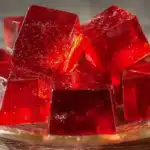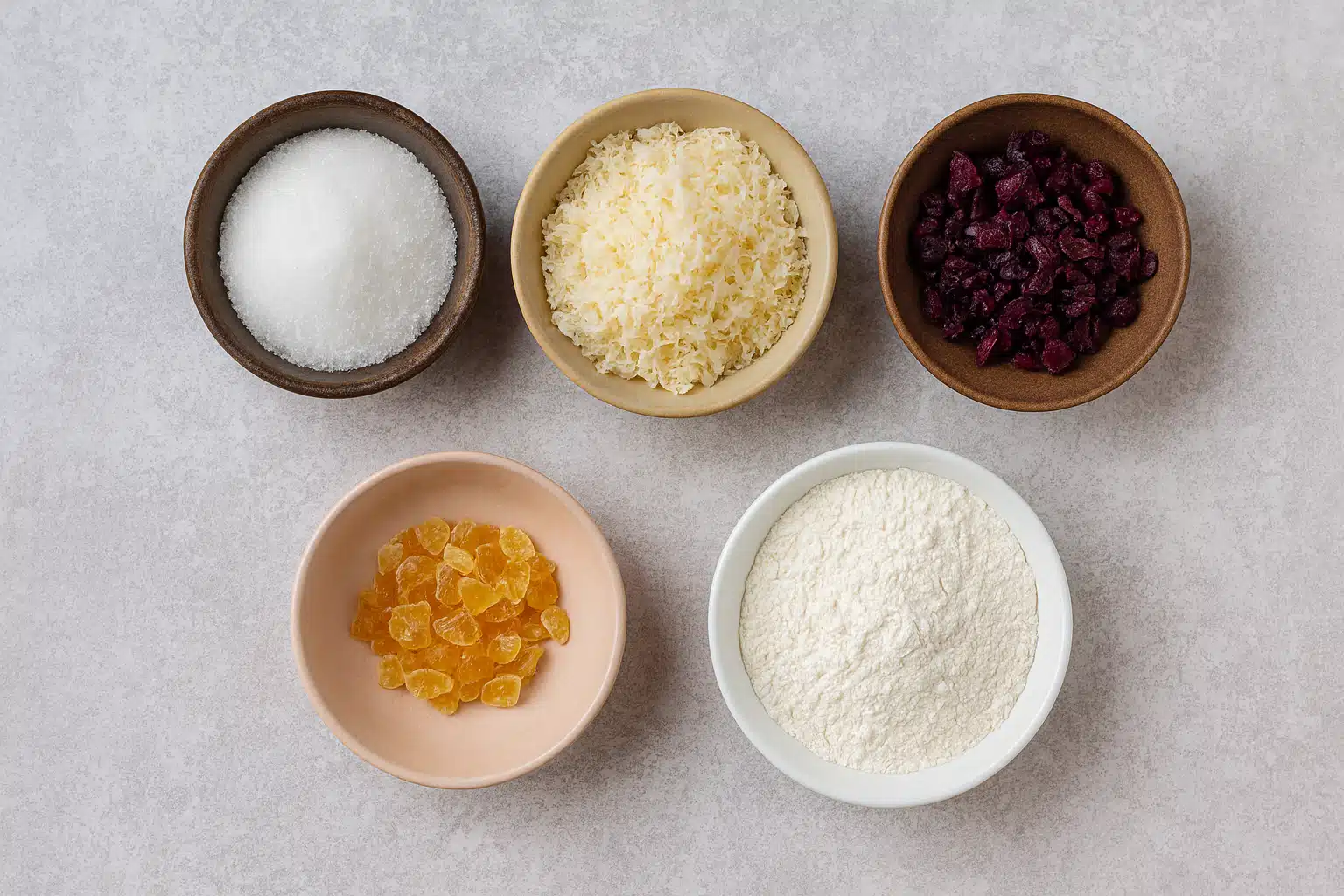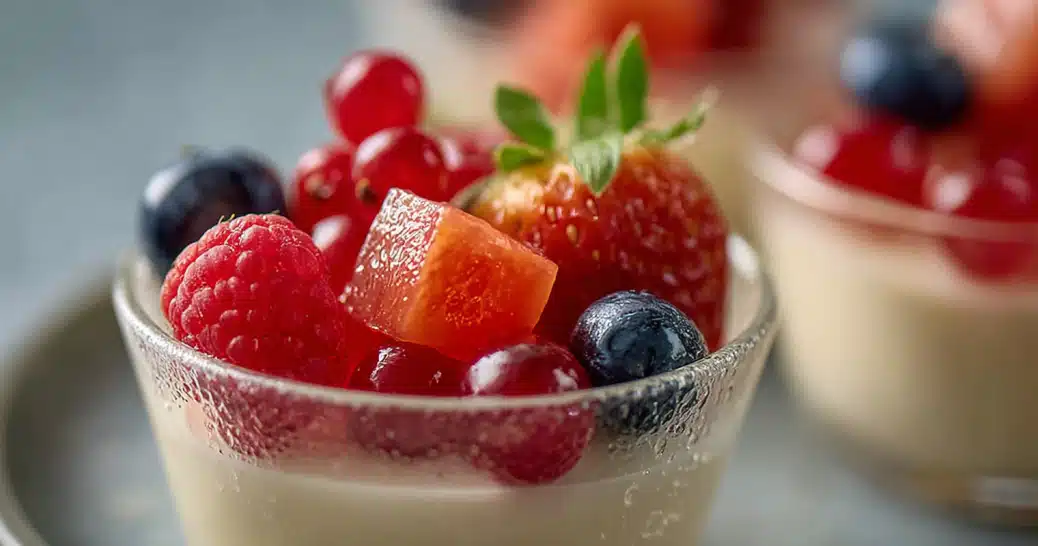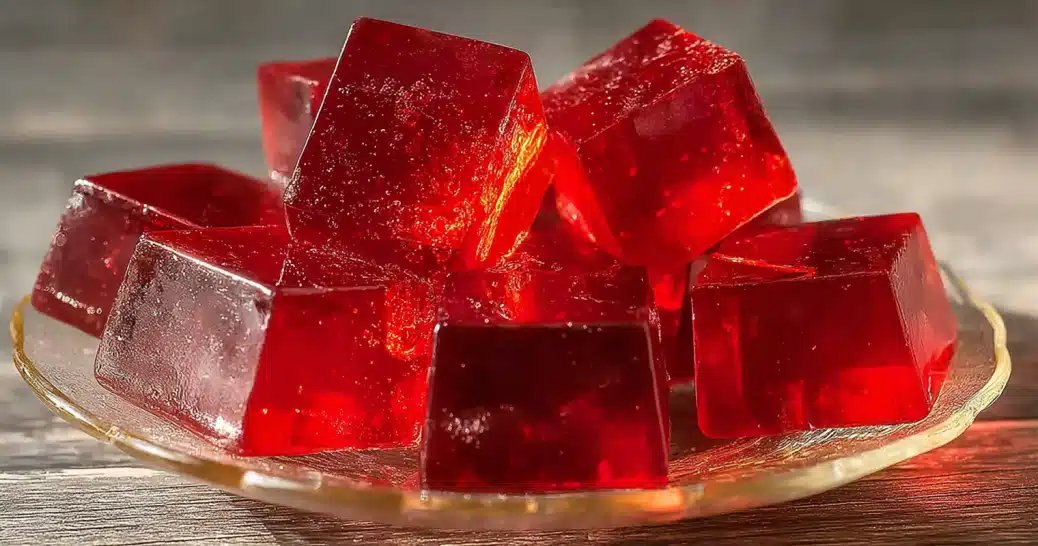Swapping traditional gelatin for vegan gelatin doesn’t mean giving up that soft, bouncy texture in your favorite desserts. In fact, vegan gelatin is opening up a whole new world of plant-based treats that are just as delicious and versatile as their animal-based versions. Whether you’re vegan, vegetarian, halal, kosher, or simply trying to avoid animal products, vegan gelatin makes it possible to enjoy puddings, jellies, and creamy custards without compromise.
It’s made from natural, sustainable sources like seaweed, fruits, and roots, and it sets beautifully in recipes that call for traditional gelatin. In this guide, you’ll discover what vegan gelatin is, how it works, and how to use it effectively in your kitchen. We’ll also explore the most common types, their unique properties, and expert tips for achieving the perfect texture every time.
Table of Contents
Understanding Vegan Gelatin
What Is Vegan Gelatin and How Does It Work?
Vegan gelatin is a plant-based gelling agent designed to replicate the texture, firmness, and versatility of animal-derived gelatin. Traditional gelatin is produced by boiling the bones, cartilage, and skin of animals to extract collagen, which forms a gel when cooled. In contrast, vegan gelatin uses plant ingredients that naturally contain or produce similar gelling properties. The most common sources are red algae, fruit peels, and root starches. These natural compounds create structure in desserts without the use of animal collagen, making them suitable for a wider range of dietary preferences.
Plant-based gelatin substitutes rely on polysaccharides such as agar, pectin, and carrageenan. These carbohydrates interact with water when heated and cooled, creating a stable gel matrix. While they may behave slightly differently than animal gelatin, they can produce equally smooth, glossy, and stable textures when handled correctly. Because these gelling agents are heat-activated, they typically need to be dissolved in boiling liquid before setting. Once cooled, the gel becomes firm and sliceable, ready for desserts, candies, or savory applications.
The Difference Between Vegan and Animal Gelatin
The main distinction between the two lies in their source and behavior during preparation. Animal gelatin is protein-based, while vegan gelatin is carbohydrate-based. This means that animal gelatin gels when cooled but melts when reheated, while vegan gelatin, particularly agar, sets firmly at room temperature and rarely remelts once it has solidified.
Here’s a quick comparison of their key properties:
| Feature | Animal Gelatin | Vegan Gelatin (Agar, Pectin, Carrageenan) |
|---|---|---|
| Source | Animal bones and skin | Plants (seaweed, fruit peels, roots) |
| Gelling temperature | Sets when chilled | Sets at room temperature |
| Texture | Soft and wobbly | Firm and clean-cut |
| Remelting ability | Can be remelted | Usually cannot be remelted |
| Dietary suitability | Non-vegan | Vegan, halal, kosher-friendly |
Understanding these differences helps you decide which gelling agent to use based on your desired outcome. For example, if you want a jiggly texture, use less agar; if you need a firm sliceable dessert, increase the ratio slightly.
Why Vegan Gelatin Is Growing in Popularity
The rise in plant-based eating has boosted demand for vegan substitutes across the culinary world, and gelatin is no exception. Beyond dietary reasons, many people choose vegan gelatin because it’s cruelty-free, allergen-friendly, and environmentally sustainable. It eliminates animal byproducts without sacrificing texture or flavor.
Vegan gelatin also aligns with clean-label trends. Many brands now highlight simple, recognizable ingredients like agar powder or citrus pectin, making them more appealing to health-conscious consumers. As vegan baking and dessert creation continue to expand, vegan gelatin provides an easy way to recreate traditional recipes with a compassionate, planet-friendly twist.
Common Ingredients Used in Vegan Gelatin
Print
Vegan Gelatin Explained: The Ultimate Guide to Using Plant-Based Substitutes
- Total Time: 10 minutes
- Yield: 4 servings 1x
- Diet: Vegan
Description
A simple, fast vegan gelatin recipe using agar agar and fruit juice.
Ingredients
1 cup fruit juice
1–2 tablespoons sugar (optional)
1 teaspoon agar agar powder
Optional: chopped fruit or edible flowers
Instructions
1. Combine fruit juice, sugar, and agar powder in a saucepan.
2. Bring to a boil, stirring for 1–2 minutes.
3. Pour into molds, add fruit if desired.
4. Cool 30 minutes at room temp, then chill until firm.
Notes
Agar sets at room temperature and is firmer than animal gelatin. Avoid raw pineapple or kiwi.
- Prep Time: 5 minutes
- Cook Time: 5 minutes
- Category: How-To Guide
- Method: Chill
- Cuisine: Vegan
Nutrition
- Serving Size: 1 cup
- Calories: 20
- Sugar: 2g
- Sodium: 5mg
- Fat: 0g
- Saturated Fat: 0g
- Unsaturated Fat: 0g
- Trans Fat: 0g
- Carbohydrates: 5g
- Fiber: 1g
- Protein: 0g
- Cholesterol: 0mg
What Is Vegan Gelatin Made Of?

Vegan gelatin is made from natural, plant-derived ingredients that can create the same smooth, jiggly texture as traditional gelatin. Instead of collagen, these substitutes rely on plant polysaccharides and fibers that form a gel when heated and cooled. The most common sources include seaweed, fruits, and root vegetables. Each ingredient has its own strengths, ideal uses, and texture results, which is why many recipes specify a particular gelling agent.
The most popular vegan gelatin ingredients include agar agar, pectin, carrageenan, and konjac. Understanding their differences will help you pick the right one for your dessert, candy, or glaze.
Agar Agar – The Most Popular Substitute
Agar agar is the most widely used vegan alternative to gelatin. It’s derived from red algae and has been a staple in Asian cuisine for centuries. Agar forms a strong, clear gel that sets at room temperature, making it perfect for layered desserts, molded jellies, and firm custards. It’s usually available as powder, flakes, or bars, but the powdered form is the easiest to work with.
Why it works well:
Agar is heat-activated. When dissolved in boiling liquid and allowed to cool, it forms a firm gel that holds its shape beautifully. It doesn’t melt easily, even in warm environments, which makes it a reliable choice for summer desserts and decorative dishes.
Best for:
- Vegan jellies and fruit desserts
- Cheesecake bases
- Layered pudding cups
- Decorative molded desserts
If you’re new to plant-based gelling, start with agar powder. It’s easy to measure and delivers consistent results.
Pectin and Fruit-Based Alternatives
Pectin is another natural gelling agent that’s commonly found in fruits such as apples, citrus peels, and berries. It’s often used in jams, jellies, and glazes because it creates a soft, spreadable texture. Pectin works best when combined with sugar and a small amount of acid, which help activate the gelling process.
Why it’s a great choice:
Pectin is fruit-derived, vegan-friendly, and ideal for recipes that already include sugar and fruit. It delivers a smooth, glossy finish and adds a natural sweetness without any aftertaste.
Best for:
- Fruit jellies and marmalades
- Dessert glazes and toppings
- Spoonable jams and preserves
If you’re making a dessert that’s naturally sweet or acidic, such as a citrus jelly or berry compote, pectin is the perfect vegan gelatin option.
Carrageenan and Konjac as Plant-Based Thickeners
Carrageenan, extracted from red seaweed, is another excellent plant-based gelling agent. It comes in different types, primarily kappa and iota, each offering a distinct texture. Kappa carrageenan creates a firm, brittle gel, while iota produces a soft, elastic one. Carrageenan is ideal for creamy or milk-based desserts because it blends smoothly with dairy or non-dairy liquids.
Why it works:
Carrageenan adds a silky, smooth structure that holds well in cold desserts. It’s often used in vegan puddings, custards, and mousse-style recipes.
Best for:
- Vegan panna cotta
- Dairy-free pudding
- Creamy gelatin-style desserts
Konjac, also known as glucomannan, comes from a root vegetable commonly used in Asian cooking. It produces a very firm, chewy gel and is often used in jelly candies or diet-friendly desserts because of its high fiber and low-calorie content.
Best for:
- Vegan jelly cups
- Low-sugar gel snacks
- Chewy gummies and candies
Both carrageenan and konjac deliver stable textures, though konjac requires precise measurement to avoid overly stiff results.
Carrageenan and Konjac as Plant-Based Thickeners
Carrageenan, extracted from red seaweed, is another excellent plant-based gelling agent. It comes in different types, primarily kappa and iota, each offering a distinct texture. Kappa carrageenan creates a firm, brittle gel, while iota produces a soft, elastic one. Carrageenan is ideal for creamy or milk-based desserts because it blends smoothly with dairy or non-dairy liquids.
Why it works:
Carrageenan adds a silky, smooth structure that holds well in cold desserts. It’s often used in vegan puddings, custards, and mousse-style recipes.
Best for:
- Vegan panna cotta
- Dairy-free pudding
- Creamy gelatin-style desserts
Konjac, also known as glucomannan, comes from a root vegetable commonly used in Asian cooking. It produces a very firm, chewy gel and is often used in jelly candies or diet-friendly desserts because of its high fiber and low-calorie content.
Best for:
- Vegan jelly cups
- Low-sugar gel snacks
- Chewy gummies and candies
Both carrageenan and konjac deliver stable textures, though konjac requires precise measurement to avoid overly stiff results.
Each plant-based ingredient brings something unique to the table. By experimenting with combinations, you can tailor your vegan gelatin to match the exact texture and finish you want in your desserts.
How to Use Vegan Gelatin in Recipes
How Do You Get Vegan Gelatin to Set Perfectly?
Using vegan gelatin isn’t complicated, but it requires understanding how each plant-based substitute behaves when heated, cooled, or combined with other ingredients. Unlike animal gelatin, which dissolves in warm water and sets as it cools, most vegan gelling agents need to be fully activated by heat. If you skip this step, your jelly or custard might not firm up correctly.
When preparing vegan gelatin, always follow three key steps: hydrate, heat, and cool. This process ensures even distribution of the gelling agent and allows it to form a stable, smooth texture. For best results, measure precisely—plant-based gels are sensitive to ratios, and even small variations can affect consistency.
Hydrating, Heating, and Cooling Techniques
Each type of vegan gelatin has its own preparation method, but the general principles are similar.
1. Hydrate the powder: Combine your vegan gelatin (such as agar or carrageenan) with a small portion of cold liquid before heating. This step helps prevent clumping and ensures the powder dissolves evenly.
2. Heat to activate: Once hydrated, bring the mixture to a gentle boil while stirring continuously. For agar agar, simmering for one to two minutes is enough to activate its gelling power. If you’re using pectin, make sure your mixture includes sugar and acid, as these trigger the gelling process.
3. Pour and cool: Pour the hot mixture into molds or serving dishes right away. Most vegan gelatins set at room temperature, so refrigeration is optional unless you prefer a chilled dessert. Once cooled, the gel will become firm and sliceable.
Keep in mind that vegan gelatin typically sets faster than animal gelatin, so work quickly once it’s heated and dissolved.
Proper Ratios for Different Textures
The right ratio determines whether your dessert turns out soft and silky or firm and sliceable. Because vegan gel agents vary in strength, always refer to the product label for guidance. Still, these general ratios are a helpful starting point:
| Type of Vegan Gelatin | Ratio per 1 Cup of Liquid | Texture Result |
|---|---|---|
| Agar agar powder | 1 teaspoon | Firm, sliceable gel |
| Agar flakes | 1 tablespoon | Medium gel |
| Pectin | 2 teaspoons (with sugar) | Soft, spreadable texture |
| Carrageenan | ½ to 1 teaspoon | Smooth, creamy consistency |
| Konjac powder | ¼ teaspoon | Very firm, chewy gel |
For fruit-based recipes, you may need slightly more agar or pectin to achieve the right firmness, as acidic ingredients can weaken the gelling process. Similarly, for creamy desserts like panna cotta, use a lighter ratio for a tender, custard-like texture.
Troubleshooting Common Setting Problems
Even experienced cooks occasionally struggle with vegan gelatin that doesn’t set as expected. Fortunately, most issues come down to small mistakes in temperature or ratios. Here’s how to fix them:
Problem 1: The gel didn’t set at all
- You may not have boiled the mixture long enough to activate the gelling agent. Always let it simmer for at least one minute.
- The ratio of powder to liquid might be too low. Try increasing it slightly and reheat the mixture.
Problem 2: The texture is too firm or rubbery
- You may have used too much powder. Vegan gelling agents are powerful, so small amounts go a long way.
- Reduce the ratio slightly or add a bit more liquid next time.
Problem 3: The gel weeps liquid after setting (syneresis)
- This can happen if the mixture cools too quickly or contains too much acid.
- Avoid adding citrus juice before boiling. Instead, mix it in after heating but before the gel sets.
Problem 4: Uneven texture or bubbles
- Always stir gently during heating to dissolve the powder evenly.
- Pour the mixture slowly into molds to avoid trapping air.
Vegan gelatin may take a little practice, but once you understand how it behaves, it becomes an easy and reliable substitute for traditional gelatin in nearly any dessert.
Comparing Vegan and Animal Gelatin
Vegan Gelatin vs Regular Gelatin
Understanding how vegan gelatin compares to animal gelatin helps you choose the right one for your recipe. While both create a gel-like consistency, their sources, chemistry, and behaviors during preparation are quite different.
Traditional gelatin is made from collagen extracted from animal bones and skin. It’s a protein-based gelling agent that softens in warm water and solidifies when cooled. Vegan gelatin, however, is plant-based, made from carbohydrates like agar, carrageenan, or pectin that gel when heated and then cooled. This core difference affects everything from texture to temperature control.
Vegan gelatin sets more firmly and faster than animal gelatin. It doesn’t melt easily once cooled, making it ideal for warm-weather desserts. Animal gelatin, on the other hand, provides a soft, elastic wobble and melts smoothly in the mouth.
| Feature | Animal Gelatin | Vegan Gelatin |
|---|---|---|
| Source | Animal bones, skin, and cartilage | Plants such as seaweed, fruit peels, and roots |
| Composition | Protein (collagen-based) | Carbohydrate (polysaccharide-based) |
| Setting behavior | Sets when chilled | Sets at room temperature |
| Melting point | Melts around body temperature | Rarely melts once set |
| Texture | Soft, wobbly, and elastic | Firm, clean-cut, and stable |
| Shelf stability | Shorter | Longer and more temperature-resistant |
| Suitability | Not vegan or halal | 100% vegan, halal, and kosher-friendly |
This comparison shows why vegan gelatin is often preferred in modern kitchens. It’s stable, ethical, and versatile, while still delivering the firmness and clarity needed for elegant desserts.
Texture, Flavor, and Temperature Differences
Texture is the most noticeable difference when switching to vegan gelatin. Traditional gelatin gives desserts that familiar jiggly, melt-in-the-mouth feel. Vegan gelatin, especially agar agar, sets more rigidly and offers a cleaner break when cut. To achieve a softer texture, simply reduce the amount of agar or add a small amount of fruit purée or milk alternative.
Flavor-wise, vegan gelatin is almost neutral. Agar and pectin have little to no taste, while carrageenan may add a slight creaminess that works beautifully in custards and puddings. Since they’re plant-based, these substitutes don’t carry any animal aftertaste, making them ideal for fruit-forward desserts.
Temperature also plays a role in usability. Animal gelatin requires refrigeration to set and melts easily when warmed. Vegan gelatin sets at room temperature and holds its shape, even under mild heat, making it perfect for layered or decorative desserts served at events.
Gelling Time and Remelting Behavior
Another key difference lies in gelling and remelting properties. Vegan gelatin, particularly agar, sets quickly and firmly within 30 minutes of cooling. Once set, it cannot be remelted and reset like traditional gelatin. This is an advantage when you need stability but a limitation if you plan to reshape or reform your dessert.
Animal gelatin allows for more flexibility because it can be gently reheated and reset. However, that also means it can lose structure if exposed to warmth for too long. Vegan gelatin maintains its form in ambient conditions, making it a more reliable choice for display desserts, cake decorations, or outdoor gatherings.
When adapting recipes, remember that vegan gelatin doesn’t behave identically to animal gelatin, so it may require minor adjustments to achieve the same mouthfeel. Over time, these tweaks become second nature, allowing you to create stunning desserts that are both ethical and delicious.
Recipes You Can Make With Vegan Gelatin
Delicious Vegan Desserts Using Plant-Based Gelatin
Vegan gelatin opens the door to a wide range of desserts, from simple jellies to creamy puddings and chewy candies. Once you understand how it sets and how much to use, you can recreate almost any gelatin-based treat in a fully plant-based version. Whether you’re craving something light and fruity or smooth and creamy, there’s a vegan gelatin recipe to match your taste.
Most of these desserts rely on agar agar or pectin, since they deliver the best balance of texture and flavor. Carrageenan works wonderfully in dairy-free recipes, while konjac is great for firm, chewy candies. The following ideas showcase how flexible vegan gelatin can be in everyday cooking.

Vegan Jellies and Fruit Cups
Vegan jellies are among the easiest desserts to make using agar or pectin. These jellies set beautifully at room temperature and hold their shape without needing refrigeration. You can make them as simple fruit cups, layered molds, or even elegant plated desserts.
How to make vegan fruit jelly cups:
- In a small saucepan, mix one cup of fruit juice with one teaspoon of agar powder.
- Bring the mixture to a boil while stirring constantly.
- Simmer for one to two minutes until the agar fully dissolves.
- Pour into cups or molds and let cool for 30 minutes.
- Refrigerate if desired, or serve as is.
For a refreshing twist, add sliced fruit or edible flowers before the gel sets. Use pectin if you prefer a softer, spoonable texture, perfect for brunches or fruit parfaits.
Dairy-Free Panna Cotta and Custards
Panna cotta is traditionally made with cream and gelatin, but vegan versions using agar agar or carrageenan achieve the same silky consistency. The trick is finding the right balance between firmness and creaminess.
How to make vegan panna cotta:
- Combine one cup of coconut milk or almond milk with one teaspoon of agar powder.
- Add sugar and vanilla or any flavoring of your choice.
- Bring to a gentle boil, stir well, and pour into serving glasses.
- Let it set at room temperature before chilling for at least one hour.
Top with fruit purée, coffee syrup, or chocolate drizzle for a luxurious finish. Carrageenan iota can also be used to create a softer, more pudding-like texture that melts gently on the tongue.
Vegan Marshmallows and Gummies
If you thought marshmallows and gummy candies were impossible without gelatin, think again. Vegan gelatin substitutes like agar and konjac can create bouncy, chewy confections with the right mix of heat, sugar, and air.
Vegan marshmallows: Combine agar agar with a sugar syrup, then whip it while it cools to trap air and create that fluffy, melt-in-your-mouth texture. Once firm, you can toast or melt them just like traditional ones.
Vegan gummies: For a firmer texture, use konjac powder with fruit juice and a touch of sweetener. Pour into silicone molds and let them set. These chewy bites make great snacks for kids and adults alike.
Layered Jello and Molded Sweets
Layered desserts are where vegan gelatin really shines. Because agar sets quickly and firmly, you can build multiple layers without them mixing together. This makes it perfect for retro-style jello desserts, festive trifle cups, or creative molded sweets.
Try alternating colors and flavors, such as mango and coconut, berry and vanilla, or coffee and almond. Pour each layer after the previous one has set, and finish with a garnish of fruit or whipped coconut cream.
These molded sweets are ideal for holidays, parties, and special occasions, adding both flavor and visual appeal to your vegan dessert table.
Vegan gelatin recipes are easy to adapt and nearly foolproof once you learn the ratios. From jellies to custards, each version showcases how plant-based ingredients can mimic traditional gelatin textures while staying fully vegan and cruelty-free.
Tips for Success With Vegan Gelatin
Best Practices for Working With Vegan Gelatin
Creating desserts with vegan gelatin can feel tricky at first, but with a few simple techniques, you can achieve perfect results every time. The key is understanding how your chosen gelling agent behaves in different recipes. Since vegan gelatin sets faster and firmer than traditional gelatin, accuracy in measurement and temperature control are essential.
Start by reading your product label carefully. Not all vegan gelatins have the same strength, so following brand-specific ratios will prevent most setting issues. Always hydrate the powder before heating and avoid skipping the simmering step. Heating fully activates the gelling compound, which ensures that your mixture sets evenly once cooled.
Another important tip is to pour your mixture into molds or cups immediately after heating, as vegan gelatin begins setting quickly. If you wait too long, it can thicken before you finish pouring, leaving uneven layers or lumps. Working efficiently and with prepped molds nearby will save time and guarantee smooth, glossy results.
Choosing the Right Gelling Agent for Each Dessert
Each plant-based gelatin substitute offers its own benefits, and choosing the right one makes all the difference in texture and appearance. Use this quick guide as a reference for your recipes:
| Dessert Type | Best Vegan Gelatin Substitute | Why It Works Best |
|---|---|---|
| Fruit Jellies | Agar Agar or Pectin | Creates a clean, firm set with bright flavor |
| Creamy Panna Cotta | Carrageenan or Agar | Delivers a smooth, silky consistency |
| Chewy Gummies | Konjac Powder | Produces a stable, flexible texture |
| Jams and Glazes | Pectin | Sets softly with sugar and acid |
| Decorative Molds | Agar Agar | Fast-setting and holds shape well |
If you’re unsure which one to use, agar powder is a reliable choice for most recipes. It’s easy to find, works quickly, and delivers consistent results across both sweet and savory dishes.
Avoiding Common Mistakes in Texture and Setting
Even small errors can change the texture of your vegan gelatin. Here are a few common pitfalls and how to avoid them:
- Not boiling long enough: Vegan gelatin must be heated to fully dissolve and activate. If you skip the simmering step, your dessert might not set at all.
- Using too little powder: Under-measuring the powder leads to soft or watery gels. Always use a precise teaspoon or kitchen scale.
- Overheating the mixture: Prolonged boiling can weaken the gelling strength, especially for pectin and carrageenan.
- Adding acidic ingredients too early: Citrus or pineapple juice can interfere with setting. Add acids after heating or once the mixture has cooled slightly.
- Refrigerating too soon: Let your gel cool and firm up at room temperature before chilling. This helps the texture remain smooth and stable.
By following these small but important steps, you’ll get consistent, professional-quality results every time.
Storing and Handling Vegan Gelatin Desserts Properly
Vegan gelatin desserts are best enjoyed fresh, but they can also be stored safely for several days if handled correctly. Once your dessert has set, cover it with plastic wrap or a tight-fitting lid to prevent it from drying out or absorbing refrigerator odors. Most agar- or pectin-based desserts will last three to five days when refrigerated.
Avoid freezing vegan gelatin, as the structure can become brittle or separate when thawed. If you need to make your desserts in advance, prepare the mixture and refrigerate it in airtight molds, then unmold and decorate just before serving.
To maintain their appearance, store vegan jellies and molded sweets away from direct sunlight or heat. Although vegan gelatin holds up better than traditional gelatin at warm temperatures, prolonged exposure can still cause minor softening or condensation on the surface.
When stored properly, vegan gelatin desserts keep their smooth, glossy texture and fresh taste, ready to impress guests or serve as a quick sweet treat during the week.
Vegan Gelatin Brands and Where to Buy Them
The Best Vegan Gelatin Brands and Products
With the growing popularity of plant-based diets, vegan gelatin alternatives are now widely available in grocery stores and online. Whether you’re an experienced vegan baker or just beginning to explore plant-based desserts, knowing which brands deliver consistent results makes your recipes much easier. The best vegan gelatin brands focus on purity, transparency, and clean ingredients without additives or artificial thickeners.
Here are some of the most reliable options you can find on the market:
- NOW Foods Agar Powder – One of the most accessible and high-quality agar products, known for its excellent gelling strength and neutral flavor. Perfect for everything from jellies to puddings.
- Bakol Jel Dessert – A ready-to-use vegan jello mix that sets just like traditional gelatin desserts. It comes in fruity flavors and is both kosher and halal certified.
- Simply Delish Plant-Based Gelatin Mix – Made with non-GMO ingredients and natural flavors, this product offers a quick, consistent set and a pleasant taste.
- Natural Desserts Unflavored Vegan Gelatin – A versatile unflavored option ideal for recipes that require custom flavoring, such as panna cotta or layered desserts.
- Telephone Brand Agar Agar Powder – A traditional brand popular in Asian cooking, known for its high-quality red algae base and superior clarity in jellies.
These brands are available through health food stores, specialty grocers, and online marketplaces such as Amazon, Thrive Market, and iHerb. Many of them come in both flavored and unflavored varieties, so you can choose based on your recipe needs.
Ingredient Transparency and Certifications
When shopping for vegan gelatin, check labels carefully. Look for certifications such as Vegan, Halal, or Kosher to confirm the product meets your dietary standards. Reputable brands also specify the source of their gelling agent, whether it’s seaweed, fruit, or root starch.
It’s best to avoid products that contain unnecessary fillers or synthetic stabilizers, as they can affect flavor and texture. Pure agar or carrageenan powders usually list just one or two ingredients, ensuring consistency and clean taste. Organic certification is a plus if you want to avoid pesticides and processed additives.
A quick label checklist for buying vegan gelatin:
- 100% plant-based ingredients
- No animal derivatives
- Certified vegan, halal, or kosher
- Non-GMO and preferably organic
- No artificial colors or preservatives
These certifications not only guarantee product quality but also align with the ethical and environmental reasons many people choose vegan gelatin in the first place.
Tips for Reading Product Labels and Avoiding Additives
Reading labels can be confusing, especially when some brands use marketing terms that sound plant-based but include hidden animal ingredients. Keep an eye out for words like collagen, gelatin, or isolate, as they often indicate non-vegan content. Genuine vegan gelatin products should list only plant-based sources such as agar agar, carrageenan, or pectin.
Some packaged “gelatin” mixes may contain sweeteners, stabilizers, or artificial flavors. While these can make desserts taste sweeter or set faster, they sometimes interfere with recipes that rely on precise textures, like panna cotta or mousse. For full control, opt for pure powders rather than flavored mixes.
If you’re purchasing online, read customer reviews for insights on setting time, texture, and flavor neutrality. Many vegan chefs prefer brands like NOW Foods Agar or Bakol for consistent performance in both professional and home kitchens.
With these trusted brands and a bit of label awareness, choosing the right vegan gelatin becomes simple. You’ll enjoy dependable results, clean ingredients, and peace of mind knowing that your desserts are 100% cruelty-free and plant-based.
Health and Environmental Benefits of Vegan Gelatin
Why Choose Vegan Gelatin Over Animal-Based Gelatin
Choosing vegan gelatin isn’t just about following a plant-based diet. It’s also a conscious decision that supports better health, environmental responsibility, and animal welfare. Traditional gelatin is derived from animal collagen, which is sourced by boiling bones, cartilage, and skin. In contrast, vegan gelatin relies on renewable plants and seaweeds that don’t involve animal exploitation or waste by-products.
For many people, switching to vegan gelatin is part of a lifestyle that values sustainability, ethical eating, and natural ingredients. It’s a simple yet impactful way to reduce reliance on animal agriculture, which is known to have one of the largest carbon footprints in food production. By using plant-based alternatives like agar, carrageenan, or pectin, you can enjoy the same culinary results while contributing to a more sustainable food system.
Ethical and Cruelty-Free Production
Vegan gelatin production completely avoids animal harm. Because it’s derived from plants such as red algae, citrus fruits, and root vegetables, no animal products or by-products are used at any stage of manufacturing. This makes it ideal not only for vegans but also for people following kosher or halal diets.
Ethical production also means cleaner supply chains. Plant-based gelling agents are harvested and processed through mechanical or low-impact chemical methods that minimize waste and environmental damage. By choosing vegan gelatin, consumers directly support cruelty-free companies and ethical sourcing practices that align with modern sustainability standards.
Sustainability and Eco-Friendly Benefits
Animal gelatin production contributes significantly to greenhouse gas emissions and water consumption. In contrast, vegan gelatin offers an eco-friendly alternative with a much lower environmental footprint. The seaweed used in agar and carrageenan, for example, grows quickly without the need for fertilizers or large amounts of fresh water. It also absorbs carbon dioxide during its growth cycle, helping offset some emissions linked to other food production.
Moreover, plant-based gelatin ingredients are biodegradable and renewable. Seaweed and fruit sources regenerate naturally, reducing pressure on ecosystems and limiting waste. Choosing vegan gelatin supports marine farming practices that can help preserve biodiversity and reduce overfishing, which indirectly benefits ocean habitats.
Many companies that produce vegan gelatin also focus on sustainable packaging and zero-waste initiatives, adding another layer of environmental benefit. By simply replacing animal-based gelatin in your desserts, you’re taking a small but meaningful step toward more eco-conscious living.
Digestive and Dietary Advantages
Vegan gelatin doesn’t contain animal collagen, cholesterol, or saturated fats. Instead, it provides a light, fiber-rich texture that’s easier for the body to digest. Ingredients like agar and pectin are natural prebiotics, supporting gut health by feeding beneficial bacteria. They also promote smoother digestion and can help maintain regularity thanks to their gentle fiber content.
In addition, vegan gelatin is suitable for people with dietary restrictions or allergies. It’s free from animal proteins, gluten, and lactose, making it a safe choice for individuals with sensitivities or religious dietary guidelines. The clean ingredient profile also appeals to health-conscious eaters who prefer foods free from additives or hidden animal derivatives.
Here’s a quick look at how vegan gelatin supports wellness:
| Benefit | Description |
|---|---|
| Digestive Support | Natural fibers like agar and pectin aid healthy digestion. |
| Allergen-Free | Free from dairy, gluten, and animal proteins. |
| Low-Calorie Option | Contains minimal calories compared to animal gelatin desserts. |
| Gut Health | Acts as a prebiotic that nourishes beneficial gut bacteria. |
| Heart-Friendly | Contains no cholesterol or saturated fats. |
These nutritional and ethical advantages make vegan gelatin an appealing choice for anyone who wants to enjoy dessert without compromise—good for you, good for the planet, and good for all living beings.
Conclusion
Vegan gelatin proves that plant-based desserts can be every bit as satisfying as their traditional versions. By using ingredients like agar agar, pectin, and carrageenan, you can create everything from chewy gummies to smooth panna cottas without relying on animal products. Beyond taste and texture, vegan gelatin supports sustainability, ethics, and better health.
Whether you’re cooking for dietary reasons or simply exploring plant-based options, vegan gelatin gives you the creative freedom to make jiggly, creamy, and elegant desserts that everyone can enjoy. Start experimenting with small batches, adjust textures to your liking, and soon you’ll master the art of vegan gelling in your own kitchen.
If you loved learning about vegan gelatin and want more plant-based dessert ideas, join our community online.
Follow us on Facebook for new recipes, quick tips, and dessert tutorials that make vegan cooking easy and fun.
Save your favorite vegan gelatin creations and discover new inspiration on Pinterest, where we share beautiful visuals, flavor ideas, and recipe boards designed for home cooks and dessert lovers.
FAQs About Vegan Gelatin
What Is Vegan Gelatin Made Of?
Vegan gelatin is made entirely from plant-based ingredients such as seaweed, fruits, and root starches. The most common sources include agar agar, pectin, carrageenan, and konjac. These natural compounds contain carbohydrates that form a gel when heated and cooled, creating the same texture and consistency as traditional gelatin without using animal collagen. Depending on your recipe, you can choose the ingredient that offers the texture you prefer—agar for firmness, pectin for softness, or carrageenan for creaminess.
What Is a Vegan Substitute for Gelatin?
The best vegan substitute for gelatin depends on the type of dessert you’re making. Agar agar is the most popular because it sets firmly and works well in jellies, puddings, and molded desserts. Pectin is perfect for fruit-based recipes, jams, and jellies, while carrageenan excels in creamy desserts like panna cotta. Konjac powder is often used for chewy textures such as gummies or jelly cups. Each of these options delivers excellent results and is completely free of animal products.
How Do You Get Vegan Gelatin?
You can find vegan gelatin in most grocery stores, health food shops, or online marketplaces. Look for pure agar powder, carrageenan, or pectin labeled as vegan or plant-based. When using it at home, activate the powder by heating it in liquid until it dissolves, then pour it into molds to set. Vegan gelatin sets faster than traditional gelatin and usually doesn’t require refrigeration, though chilling it will make the texture smoother and firmer.
Is Knox Unflavored Gelatin Vegan?
No, Knox Unflavored Gelatin is not vegan. It’s made from animal collagen, usually sourced from pig or cow bones and skin. If you want a vegan-friendly alternative, use agar agar powder or Bakol Jel Dessert, both of which set beautifully and are 100% plant-based. Always check the label—any product that lists “collagen” or “gelatin” as an ingredient is animal-derived and therefore not vegan.
Does agar agar set like gelatin?
Yes, but agar sets more firmly and at room temperature, while traditional gelatin sets softly when chilled.
Why didn’t my vegan jelly set properly?
It might not have boiled long enough, or the ratio of powder to liquid was too low. Always simmer agar or carrageenan for one to two minutes to fully activate its gelling properties.
Can I make vegan gelatin without agar?
Yes, you can use pectin, carrageenan, or konjac powder as alternatives. Each has unique textures that suit different dessert types.











